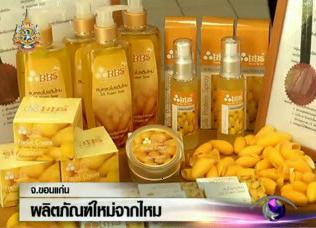Founded to study and develop sericulture, or silk farming, the university’s Silk Innovation Center was founded to extend well-being to the rural communities which depend upon income from the worm that are a girl’s best friend. Inside the centre a painting of HRH Princess Sirindhorn, created on a shimmering sheet of handmade yellow silk fiber paper displayed prominently in the facility, shows one result of the applied research to use silk yarn in artwork besides using it to make fabric for fashions and other clothing.
Mahasarakham University’s forward-looking president, Asst Prof Supachai Samappito, notes that “Usually, we raise silkworms in ‘Jor’, as the large, round, flat bamboo trays are called in Thai, and the little creatures spin their cocoons in them. Researchers later discovered that if the silkworms are placed on smooth surfaced materials, such as mirrors, wood, plastic, or paper, then we can get the silkworm’s threads spread in sheetlike form.”
 Silk is Thailand’s most elegant natural fiber, used mainly for textile manufacturing. Due to a decline in prices in worldwide markets for the famed fiber, Mahasarakham University researchers have developed innovative and varied products made from silk in order to help silk farmers to claim additional income from silk production when the market prices of silk have dropped.
Silk is Thailand’s most elegant natural fiber, used mainly for textile manufacturing. Due to a decline in prices in worldwide markets for the famed fiber, Mahasarakham University researchers have developed innovative and varied products made from silk in order to help silk farmers to claim additional income from silk production when the market prices of silk have dropped.
Silk fiber paper production begins with placing silkworms on the wooden board or framed sheet with nylon netting on it. The size of the board depends on the quantity of silkworms available, but usually the concentration is some 300 silkworms per square metre,” says Prof Supachai. After silkworms churn out for about two or three days, and then the silk sheet can be peeled off the board and ready for use as silk paper. The shimmering yellow silk ‘paper’ usually sells for Bt700-1,000 per square metre.
The sparkling texture of silk paper used for painting helps create a three-dimensional quality for pictures, making them look more valuable.
Besides silk paper, the Silk Innovation Center has also produced many products for beauty care applications by protein extraction from cocoons. The protein called sericin can retain skin moisture, slow down wrinkles, and protect skin from ultraviolet (UV) rays.
“Silk has been used in medical applications for many years as the protein from cocoons is structurally similar to that of human beings. Silk protein is easily-absorbed into the skin and can prevent a drop in water levels beneath the outermost skin layer. An added benefit is that Thai silk can provide us more moisture than silk produced in other countries.”
As its special properties, silk protein has been used in many beauty and skin care products such as solid soap, liquid soap, water spray, and moisturising cream. Incomes from selling these products, which are available in Mahasarakham University, will support further studies related to growing mulberry for raising silkworms instead of depending on budgets allocated from the government. The developed technology and knowledge could be passed on to communities to add value to silk farmers’ products.
In addition to beauty products, the centre also produces silk products for health applications; for example, mulberry tea and crispy rice snacks made from silkworms. (MCOT online news)




